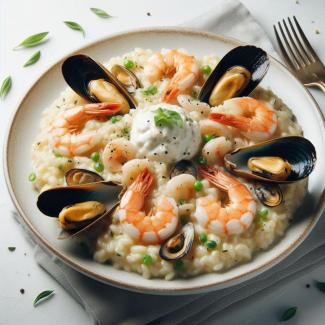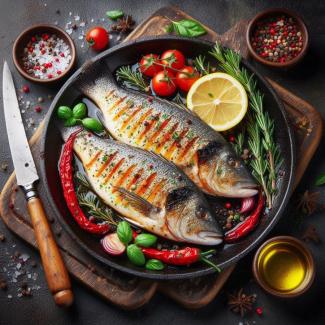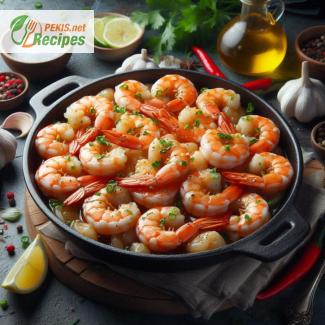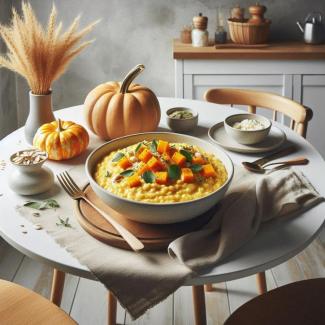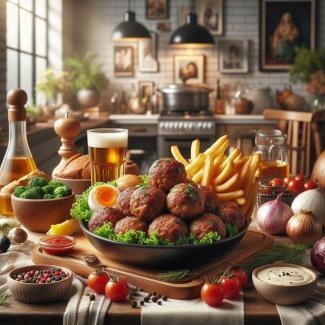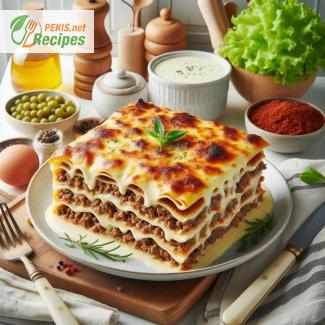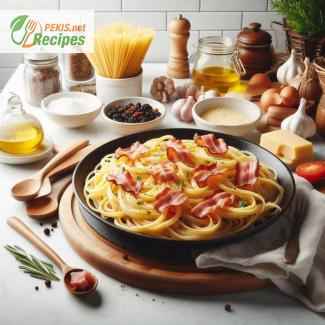
Indulge in the rich, creamy decadence of an authentic Carbonara, a timeless Italian classic that transports you straight to the heart of Rome. This dish is celebrated for its simplicity and elegance, yet it boasts layers of deep, savory flavors that come together harmoniously. The star of this recipe is pancetta, which lends a distinctive richness and saltiness, infusing every bite with a mouthwatering, meaty depth. Unlike other pasta dishes, Carbonara is crafted without cream, relying on a silky blend of fresh eggs and grated Pecorino Romano to create its velvety sauce. The eggs are carefully tossed with hot pasta—typically spaghetti or rigatoni—until they form a luscious coating, clinging perfectly to each strand or tube.
The pancetta, gently sautéed in olive oil, releases its natural fat and develops a crispy, caramelized exterior, adding texture and smoky undertones to the dish. As you twirl your fork through the pasta, you’ll encounter delicate morsels of pancetta that offer a delightful contrast to the smoothness of the sauce. A generous sprinkle of freshly cracked black pepper provides a peppery kick, enhancing the bold, tangy notes of the Pecorino Romano, while adding a subtle heat that cuts through the richness of the sauce.
What makes Carbonara truly special is the perfect balance of flavors: the sharpness of the cheese, the robust saltiness of the pancetta, and the creamy, eggy coating that binds it all together. The dish is best served immediately, piping hot, allowing the sauce to maintain its luxurious texture. Pair it with a crisp white wine to complement the richness of the pancetta, and savor the authentic taste of Italy in every bite.
Whether enjoyed as a hearty lunch or a sophisticated dinner, authentic Carbonara with pancetta is a celebration of simplicity, tradition, and the pure joy of Italian cuisine.
- Prepare the Pasta:
- Bring a large pot of salted water to a boil. Add the spaghetti and cook according to the package instructions until al dente (firm to the bite), usually around 8-10 minutes.
- Cook the Pancetta:
- While the pasta is cooking, heat 2 tablespoons of olive oil in a large skillet over medium heat. Add the diced pancetta and cook for 5-7 minutes, stirring occasionally, until the pancetta is crispy and golden. Turn off the heat and set aside.
- Prepare the Egg Mixture:
- In a medium bowl, whisk the eggs until smooth. Add the grated Pecorino Romano and Parmigiano-Reggiano cheeses, and season with freshly ground black pepper. Stir until the mixture becomes creamy and thick.
- Combine the Ingredients:
- Once the pasta is cooked, reserve about 100 ml (½ cup) of the pasta cooking water and drain the rest. Immediately add the hot pasta to the skillet with the pancetta (without turning on the heat) and toss to combine.
- Gradually pour the egg and cheese mixture over the pasta while tossing quickly to avoid scrambling the eggs. The heat from the pasta will create a creamy sauce. If the mixture seems too thick, add a small amount of the reserved pasta water until the sauce reaches the desired consistency.
- Final Seasoning:
- Taste the pasta and adjust the seasoning with more pepper if needed. Depending on the saltiness of the pancetta and cheese, you may not need to add extra salt.
- Serve:
- Serve the Carbonara immediately, garnished with a little extra grated Pecorino Romano and a final twist of black pepper.
This recipe offers the perfect balance of creamy texture and rich flavor, giving you a taste of true Italian Carbonara. Enjoy it with a crisp white wine or a light salad for a complete meal.
Nutritional Breakdown and Health Impact of Authentic Carbonara with Pancetta
1. Carbohydrates from Pasta (Spaghetti):
- Quantity (per serving): 53 g
- Effect on the Body: Carbohydrates are the body’s primary source of energy, and the spaghetti in Carbonara provides a significant amount of this macronutrient. When consumed, carbohydrates are broken down into glucose, which fuels bodily functions, physical activity, and brain function. The fiber content in whole wheat pasta, if used, also promotes digestive health by supporting regular bowel movements and contributing to gut health. However, refined white pasta has a higher glycemic index, which can cause a quicker rise in blood sugar levels, so it is better to balance it with fiber-rich vegetables in the diet.
2. Protein from Eggs, Pancetta, and Cheese:
- Quantity (per serving): 23 g
- Effect on the Body: Protein is vital for building and repairing tissues, including muscles, skin, and internal organs. The eggs, pancetta, and cheese in Carbonara provide high-quality protein, rich in essential amino acids that the body cannot produce on its own. Protein also plays a key role in enzyme function, hormone regulation, and immune system support. While animal-based proteins are highly bioavailable, they also come with saturated fats, which should be moderated in a heart-healthy diet. Eggs are also a good source of vitamins like B12 and riboflavin, essential for energy metabolism and red blood cell production.
3. Fat from Pancetta, Cheese, and Olive Oil:
- Quantity (per serving): 25 g (with 8 g saturated fat)
- Effect on the Body: The fats in Carbonara come from pancetta, cheese, and olive oil. Dietary fat is essential for absorbing fat-soluble vitamins (A, D, E, and K), providing energy, and supporting cell structure. The olive oil used in this recipe contains heart-healthy monounsaturated fats, known to improve cholesterol levels and reduce the risk of heart disease. However, pancetta and cheese contribute a significant amount of saturated fat, which, in excess, can increase LDL (bad) cholesterol and raise the risk of cardiovascular issues. Balancing this with unsaturated fats (such as those in olive oil or nuts) in the diet is crucial for heart health.
4. Cholesterol from Eggs and Pancetta:
- Quantity (per serving): 140 mg
- Effect on the Body: Cholesterol is necessary for building cell membranes and producing hormones like estrogen and testosterone. However, dietary cholesterol, particularly from animal-based sources such as eggs and pancetta, can contribute to increased blood cholesterol levels in some individuals, particularly if they are predisposed to high cholesterol or have a diet rich in saturated fats. The current understanding suggests that moderate egg consumption is not linked to an increased risk of heart disease for most people, but those with existing cholesterol issues should monitor their intake.
5. Calcium from Cheese (Pecorino Romano and Parmigiano-Reggiano):
- Effect on the Body: The cheese in Carbonara is rich in calcium, an essential mineral for maintaining strong bones and teeth. Calcium also plays a critical role in muscle contraction, nerve function, and blood clotting. Consuming adequate calcium is crucial for preventing osteoporosis and maintaining bone density, especially as people age. The high concentration of calcium in Pecorino Romano and Parmigiano-Reggiano helps support these bodily functions but should be balanced with mindful portion control due to the high sodium content in these cheeses.
6. Sodium from Pancetta and Cheese:
- Quantity (per serving): 600 mg
- Effect on the Body: Sodium is essential for maintaining fluid balance, nerve transmission, and muscle function. However, too much sodium in the diet can lead to high blood pressure, which increases the risk of heart disease and stroke. The pancetta and cheese in Carbonara are significant sources of sodium, making this dish relatively high in salt. While the sodium content is manageable for individuals with low-sodium diets, those with hypertension or cardiovascular concerns should be cautious about regularly consuming salty foods. To balance sodium intake, focus on incorporating more potassium-rich foods like fruits and vegetables, which can help counteract the effects of sodium on blood pressure.
7. Fiber (Minimal):
- Effect on the Body: Traditional Carbonara made with refined white spaghetti offers little dietary fiber. Fiber is essential for digestive health, helps regulate blood sugar levels, and lowers cholesterol. To increase fiber content, consider using whole wheat pasta or adding fiber-rich vegetables like peas, spinach, or mushrooms into the dish. These additions can help slow digestion and promote feelings of fullness, making the meal more balanced and beneficial for overall health.
8. Black Pepper:
- Effect on the Body: Black pepper, though used in small quantities, has its own health benefits. It contains piperine, which enhances the absorption of nutrients such as curcumin (found in turmeric) and beta-carotene. Black pepper also has antioxidant properties and may support digestion by stimulating the production of digestive enzymes.
Health Considerations:
- Weight Management: Carbonara is a calorie-dense dish due to its combination of fats, carbohydrates, and proteins. For individuals mindful of their calorie intake or trying to manage weight, portion control is essential. Opting for smaller servings or pairing the dish with a side salad or vegetables can help create a more balanced meal that provides satiety without excess calories.
- Cardiovascular Health: While this dish offers nutrients like monounsaturated fats from olive oil and calcium from cheese, it also contains saturated fats and sodium, both of which are linked to increased risk of cardiovascular disease when consumed in excess. Moderation and the inclusion of heart-healthy ingredients in other meals throughout the day can help offset these effects.
- Bone Health: The calcium and protein in this dish are beneficial for maintaining strong bones and preventing osteoporosis, particularly in postmenopausal women and older adults. Regular consumption of calcium-rich foods like cheese, alongside other calcium sources like leafy greens and dairy, supports long-term bone health.
- Digestive Health: The low fiber content of traditional Carbonara may contribute to digestive sluggishness, especially if the rest of the diet lacks fiber. Integrating whole grains or vegetables into the dish, or pairing it with a fiber-rich side, can support digestive health and help maintain regularity.
Authentic Carbonara with Pancetta offers a delightful combination of flavors and nutrients, but like many rich Italian dishes, it is best enjoyed in moderation. The dish provides a good balance of carbohydrates, fats, and protein, making it a satisfying meal, but it also contains high amounts of sodium and saturated fat. For those looking to maintain a balanced and healthy diet, incorporating more vegetables, fiber, and unsaturated fats into other meals can help maintain overall health while still indulging in the deliciousness of a classic Carbonara.
How Often Should Carbonara Be on Your Menu?
Authentic Carbonara with pancetta is a rich and indulgent dish, and while it’s delicious, it’s best enjoyed in moderation due to its high content of saturated fats, cholesterol, and sodium. For those looking to maintain a balanced and heart-healthy diet, Carbonara should be considered an occasional treat rather than a regular part of the weekly menu. Having it once or twice a month allows you to enjoy its creamy, savory flavors without compromising your overall nutritional goals.
If you're mindful of weight management or heart health, pairing Carbonara with lighter meals throughout the day or week can help balance its calorie-dense and fat-rich composition. Including more plant-based meals or those rich in vegetables and lean proteins on the other days of the week will create a more varied and health-conscious eating plan.
General Tips for This Recipe:
- Portion Control: Given its richness, you can enjoy a smaller portion of Carbonara alongside a fresh salad or steamed vegetables. This helps balance the meal with fiber, vitamins, and minerals that are otherwise lacking in the dish.
- Use Whole Wheat Pasta: For a healthier alternative, swap traditional spaghetti for whole wheat pasta. This simple change increases fiber content, which promotes better digestion and helps you feel fuller for longer.
- Reduce Salt Content: Pancetta and cheese are naturally salty, so avoid adding extra salt during the cooking process. This can help reduce the overall sodium content of the dish.
- Lean Meat Alternatives: For a lower-fat version, consider using leaner meats like turkey bacon or prosciutto instead of pancetta. While these alternatives change the flavor slightly, they can still offer the savory, crispy element of pancetta with fewer calories and saturated fats.
- Vegetable Additions: To make the meal more nutritionally balanced, you can add vegetables like peas, mushrooms, or spinach to the dish. This adds vitamins, minerals, and fiber while enhancing the flavor profile.
By keeping these considerations in mind, you can still enjoy the comforting flavors of Carbonara while maintaining a healthier and more balanced diet.

